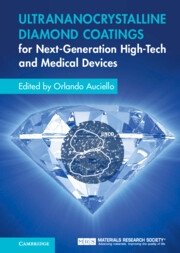Book contents
- Ultrananocrystalline Diamond Coatings for Next-Generation High-Tech and Medical Devices
- Ultrananocrystalline Diamond Coatings for Next-Generation High-Tech and Medical Devices
- Copyright page
- Contents
- Contributors
- Preface
- 1 Fundamentals on Synthesis and Properties of Ultrananocrystalline Diamond (UNCD™) Coatings
- 2 Ultrananocrystalline Diamond (UNCD™) Film as a Hermetic Biocompatible/Bioinert Coating for Encapsulation of an Eye-Implantable Microchip to Restore Partial Vision to Blind People
- 3 Science and Technology of Ultrananocrystalline Diamond (UNCD™) Coatings for Glaucoma Treatment Devices
- 4 Science and Technology of Novel Integrated Biocompatible Superparamagnetic Oxide Nanoparticles Injectable in the Human Eye and External Ultrananocrystalline Diamond (UNCD™)-Coated Magnet for a New Retina Reattachment Procedure
- 5 Science and Technology of Biocompatible Ultrananocrystalline Diamond (UNCD™) Coatings for a New Generation of Implantable Prostheses
- 6 Science and Technology of Novel Ultrananocrystalline Diamond (UNCD™) Scaffolds for Stem Cell Growth and Differentiation for Developmental Biology and Biological Treatment of Human Medical Conditions
- 7 New Generation of Li-Ion Batteries with Superior Specific Capacity Lifetime and Safety Performance Based on Novel Ultrananocrystalline Diamond (UNCD™)-Coated Components for a New Generation of Defibrillators/Pacemakers and Other Battery-Powered Medical and High-Tech Devices
- 8 Science and Technology of Integrated Nitride Piezoelectric/Ultrananocrystalline Diamond (UNCD™) Films for a New Generation of Biomedical MEMS Energy Generation, Drug Delivery, and Sensor Devices
- 9 Science and Technology of Integrated Multifunctional Piezoelectric Oxides/Ultrananocrystalline Diamond (UNCD™) Films for a New Generation of Biomedical MEMS Energy Generation, Drug Delivery, and Sensor Devices
- 10 Biomaterials and Multifunctional Biocompatible Ultrananocrystalline Diamond (UNCD™) Technologies Transfer Pathway
- Index
- References
7 - New Generation of Li-Ion Batteries with Superior Specific Capacity Lifetime and Safety Performance Based on Novel Ultrananocrystalline Diamond (UNCD™)-Coated Components for a New Generation of Defibrillators/Pacemakers and Other Battery-Powered Medical and High-Tech Devices
Published online by Cambridge University Press: 08 July 2022
- Ultrananocrystalline Diamond Coatings for Next-Generation High-Tech and Medical Devices
- Ultrananocrystalline Diamond Coatings for Next-Generation High-Tech and Medical Devices
- Copyright page
- Contents
- Contributors
- Preface
- 1 Fundamentals on Synthesis and Properties of Ultrananocrystalline Diamond (UNCD™) Coatings
- 2 Ultrananocrystalline Diamond (UNCD™) Film as a Hermetic Biocompatible/Bioinert Coating for Encapsulation of an Eye-Implantable Microchip to Restore Partial Vision to Blind People
- 3 Science and Technology of Ultrananocrystalline Diamond (UNCD™) Coatings for Glaucoma Treatment Devices
- 4 Science and Technology of Novel Integrated Biocompatible Superparamagnetic Oxide Nanoparticles Injectable in the Human Eye and External Ultrananocrystalline Diamond (UNCD™)-Coated Magnet for a New Retina Reattachment Procedure
- 5 Science and Technology of Biocompatible Ultrananocrystalline Diamond (UNCD™) Coatings for a New Generation of Implantable Prostheses
- 6 Science and Technology of Novel Ultrananocrystalline Diamond (UNCD™) Scaffolds for Stem Cell Growth and Differentiation for Developmental Biology and Biological Treatment of Human Medical Conditions
- 7 New Generation of Li-Ion Batteries with Superior Specific Capacity Lifetime and Safety Performance Based on Novel Ultrananocrystalline Diamond (UNCD™)-Coated Components for a New Generation of Defibrillators/Pacemakers and Other Battery-Powered Medical and High-Tech Devices
- 8 Science and Technology of Integrated Nitride Piezoelectric/Ultrananocrystalline Diamond (UNCD™) Films for a New Generation of Biomedical MEMS Energy Generation, Drug Delivery, and Sensor Devices
- 9 Science and Technology of Integrated Multifunctional Piezoelectric Oxides/Ultrananocrystalline Diamond (UNCD™) Films for a New Generation of Biomedical MEMS Energy Generation, Drug Delivery, and Sensor Devices
- 10 Biomaterials and Multifunctional Biocompatible Ultrananocrystalline Diamond (UNCD™) Technologies Transfer Pathway
- Index
- References
Summary
This chapter focuses on a description of a novel UNCD film-based technology enabling a new generation of Li-ion batteries (LIB) with orders of magnitude longer stable specific capacity vs. charge/discharge cycles and safer performance than current devices, to power a new generation of miniaturized defibrillators/pacemakers to improve the quality of life of people receiving them.The UNCD film technology provides three new key components of the LIB, namely: 1) Electrically conductive Nitrogen atoms-grain boundary incorporated ultrananocrystalline diamond (N-UNCD) films encapsulating natural graphite (NG)/copper composite LIB anodes, providing order of magnitude superior cycle performance and capacity retention than for NG/Cu anodes (the N-UNCD layer suppresses reactions of NG with the electrolyte and the development of insulating solid-electrolyte-interphase (SEI) on the anode, which retards anode conductivity and induces stresses, leading to cracks in the NG particles inducing loss of contact between them); 2) UNCD-coated Si-based membranes with orders of magnitude higher resistance to chemical attack than membranes in current LIBs; and 3) UNCD coatings for the inner walls of battery cases to enable use of less expensive case materials than current ones.
Keywords
- Type
- Chapter
- Information
- Ultrananocrystalline Diamond Coatings for Next-Generation High-Tech and Medical Devices , pp. 197 - 213Publisher: Cambridge University PressPrint publication year: 2022

